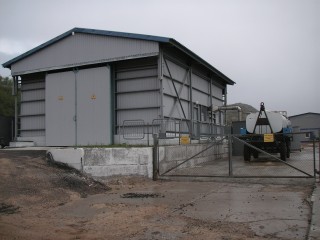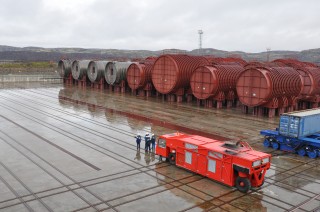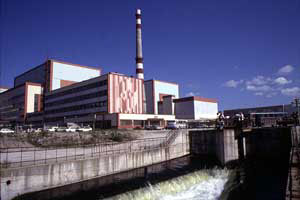
The system built to manage Russia’s nuclear legacy is crumbling, our new report shows
Our op-ed originally appeared in The Moscow Times. For more than three decades, Russia has been burdened with the remains of the Soviet ...
News

Publish date: December 16, 2014
Written by: Anna Kireeva
News
The recent souring of Moscow’s relations with the West and the financial and economic sanctions imposed against Russia are not expected to affect the nuclear and radiation safety projects Russia is implementing with the help of Western funds in the country’s northwest.
International sanctions have not been a factor for the nuclear and radiation safety projects in Russia’s Northwest, so all the major areas of work are proceeding as planned, Inger Margrethe Eikelmann, a department head at the Norwegian Radiation Protection Agency (NRPA), said at the seminar “Russia’s Atomic Energy: Conditions, Tendencies and Safety” in the Norwegian capital last week.
“One of the most important projects for the Norwegian side is preparations for the removal of nuclear submarine spent fuel out of Andreyeva Bay,” Eikelmann said.

According to Eikelmann’s assurances, Russia and Norway will continue their joint work studying the radioactive objects dumped in the Kara Sea during Soviet times and joint monitoring of the situation with the nuclear submarine K-159, which sank in Kola Bay in the Barents Sea during towing in 2003.
Eikelmann’s words were echoed by Denis Pleshchenko, head of communications department at the state-owned RosRAO, a Russian State Atomic Energy Corporation Rosatom entity responsible for management of radioactive waste in Russia. Pleshchenko said Western sanctions had practically had no impact on the projects under implementation.
“We have confirmation from the Norwegian side regarding the implementation of projects in Andreyeva Bay. All the agreements remain in force and are confirmed. The project of building a [radioactive waste] treatment center in Sayda Bay, financed by Germany, will be launched for a trial run in the winter of 2015,” Pleshchenko said.
Foreign donor countries have been helping Russia clean up its legacy nuclear and radioactive hot spots in the Northwest – old naval bases, sites and facilities storing spent nuclear fuel, radioactive waste and submarine reactors, accumulated over the decades of the Northern Fleet’s operation – since the 1990s, when Bellona raised concerns over nuclear and radiation safety in the region. Russia’s economic conditions at the time put financing of the cleanup works out of Russia’s reach, and numerous agreements were concluded over the following years to secure foreign aid to tackle the problem.
A number of them dealt with Andreyeva Bay, a former naval base located just 45 kilometers from the Russian-Norwegian border. The largest point of storage for the Northern Fleet’s spent nuclear fuel and radioactive waste, the base became the site of a severe accident in the early 1980s, when one of the cooling pools with spent fuel developed a leak and radioactive water started seeping under the building, and from there made its way into the Barents Sea.

And Sayda Bay is a site in Kola Bay where in 1990 Russia organized temporary storage for reactor compartments removed from nuclear submarines undergoing decommissioning. By 2003, when dozens of reactor compartments, some with spent fuel on board, were already bobbing in the water at Sayda Bay piers, a permanent onshore storage facility had not yet been built. Germany was instrumental in bringing this project to fruition and securing the reactor compartments’ safety.
Bellona’s president Frederic Hauge is confident that whichever way the political and international winds may blow, the ecological projects must go on.
“Yes, the international situation has changed, but nothing has changed for Bellona. Environmental problems remain, and we need to continue to solve them. To do that, we will continue our cooperation with all the concerned parties,” Hauge said.
According to Bellona’s recent report “Remediation of nuclear and radiation-hazardous sites in Russia’s Northwest: An overview of projects carried out as part of international cooperation,” (in Russian) Norway since 2002 has annually contributed around €10 million to projects in Russia’s Northwest, including funds donated to build a spent nuclear fuel and radioactive waste management complex and other infrastructure.
As of 2014, work continued in Andreyeva Bay that was started in 1999: a comprehensive engineering and radiation survey at the stage of designing the spent fuel and radioactive waste management complexes. Additionally, Norway’s funding was used to decommission five nuclear submarines and 251 radioisotope thermoelectric generators (RTGs) – autonomous devices that run on radionuclides and are widely used as a power source for light beacons.
The overall cost of spent fuel and radioactive waste removal works in Andreyeva Bay is around €55 million, Bellona’s report said. The work is being financed by the EBRD. Russia’s participation is estimated at €15 million. The environmental rehabilitation at the former naval base is scheduled to be completed by 2025. In Russia’s estimates, no less than €1.5 billion will be required over the next 15 years to convert Andreyeva Bay into a brownfield.
As for other donor nations that took part in the remediation efforts, the U.S. and the Group of Eight members – which in 2002 pledged $20 billion to help Russia safeguard its legacy sites in the Northwest – have mostly completed their assigned tasks.
Further work for now remains to be done in Andreyeva Bay, and another site to check on the to-do list is the former naval base Gremikha, on the eastern coast of the Kola Peninsula. Gremikha was the second major storage site for naval nuclear waste and the largest site where decommissioned nuclear submarines were laid up. By 2025, Gremikha is to be cleaned up completely from the spent fuel and radioactive waste accumulated there, and its territory to be rehabilitated.
The Kola nuclear plant and international help
A major part of discussion at the seminar revolved around extending the operational lifetime of the Kola Nuclear Power Plant, in Murmansk Region, and increasing the reactor’s power output

. Norway had invested significant funds to ensure nuclear and radiation safety enhancement at the station’s reactors.
This, in part, was what made it possible for the power plant to secure license extensions for the old reactors beyond their 30 years of designed service life.
Responding to Norwegian environmentalists’ complaints that Norwegian funding went toward facilitating license extensions for the Kola reactors, the NRPA’s Eikelmann said the authority has never approved of the practice.
“We have always expressed concern regarding the extension of the old reactors[’ service life]. We are absolutely against it, considering that these are first-generation reactors, and there is a risk of accidents developing. At the time Norway could have chosen not to do anything – or to invest money into increasing safety. We chose the second option,” Eikelmann said.
The Oslo seminar made a point of hosting not only representatives of Rosatom and the NRPA, but representatives of Russian and Norwegian environmental organizations as well, to promote discussion and help provide answers to the environmentalists’ long-standing questions.
Representatives of Kola Nuclear Power Plant, however, were the only invited Rosatom representatives who failed to participate.

Our op-ed originally appeared in The Moscow Times. For more than three decades, Russia has been burdened with the remains of the Soviet ...

The United Nation’s COP30 global climate negotiations in Belém, Brazil ended this weekend with a watered-down resolution that failed to halt deforest...

For more than a week now — beginning September 23 — the Zaporizhzhia Nuclear Power Plant (ZNPP) has remained disconnected from Ukraine’s national pow...

Bellona has taken part in preparing the The World Nuclear Industry Status Report 2025 and will participate in the report’s global launch in Rome on September 22nd.